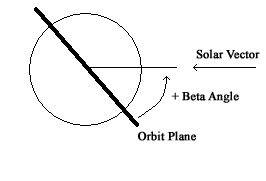Beta angle: Difference between revisions
m Quick-adding category Earth orbits (using HotCat) |
m Quick-adding category Astrodynamics (using HotCat) |
||
| Line 20: | Line 20: | ||
[[Category:Spaceflight]] |
[[Category:Spaceflight]] |
||
[[Category:Earth orbits]] |
[[Category:Earth orbits]] |
||
[[Category:Astrodynamics]] |
|||
Revision as of 09:38, 14 June 2009
Template:Expert-subject-multiple

The beta angle is a value that is used most notably in spaceflight. The beta angle defines the percentage of time an object such as a spacecraft in low earth orbit (LEO) spends in direct sunlight, absorbing solar energy.[1] Beta angle is defined as the angle between the orbit plane and the vector from the sun.[2] The percent sunlight does not fall below 59% for normal low Earth orbit missions.[1][2]
Orbital shadowing interacts with the beta angle. An object launched into a polar orbit at local noon or midnight results in an initial beta angle of 0 degrees for the orbiting object. This allows the object to spend the maximum possible amount of its orbital period in the earth's shadow, and results in extremely reduced absorption of solar energy. At a LEO of 280 kilometers the object in orbit is in sunlight through 59% of its orbit (approximately 53 minutes in sunlight, and 37 minutes in shadow.[2]) On the other extreme, an object launched into a polar orbit at local dawn or dusk results in a beta angle of 90 degrees, and the object is in sunlight 100% of the time.[2]
Beta angle is a function of several variables: Inclination of the orbit, altitude, time of the mission, time of year of launch, and time of day of the launch. It varies as the mission progresses due to changes in the Earth-Sun inertial relationship (rotation of the Earth about the Sun), and orbit precession effects (non-uniformity of the Earth's gravitational field, etc.). The extreme values of beta angle over a years time for a mission launched at a given orbit inclination, , varies ± 23.45 degrees. In other words, for a due east launch from the Kennedy Space Center, =28.5 degrees, and the beta angle will vary from about +52 degrees to -52 degrees over the course of a year.[2]
The effect of the beta angle on shuttle missions is an important consideration for shuttle missions to the International Space Station, resulting in time periods referred to as "beta cutout".[1] When the orbiter is in-flight (not docked to ISS) and it gets to a beta angle greater than 60 degrees, the orbiter goes into "rotisserie" mode, and slowly rotates around its X-axis (nose to tail axis). For flights to ISS, the shuttle can launch during an ISS beta cutout if the ISS will be at a beta less than 60 degrees at dock, and throughout the docked phase.[citation needed] Therefore, the mission duration affects launch timing when the beta cutout dates are approaching.
References
- ^ a b c Derek Hassman, NASA Flight Director (December 1, 2002). "MCC Answers". NASA. Retrieved June 14, 2009.
- ^ a b c d e K&K Associates (2008). "Earth's Thermal Environment". Thermal Environments JPL D-8160. K&K Associates. Retrieved July 14, 2009.